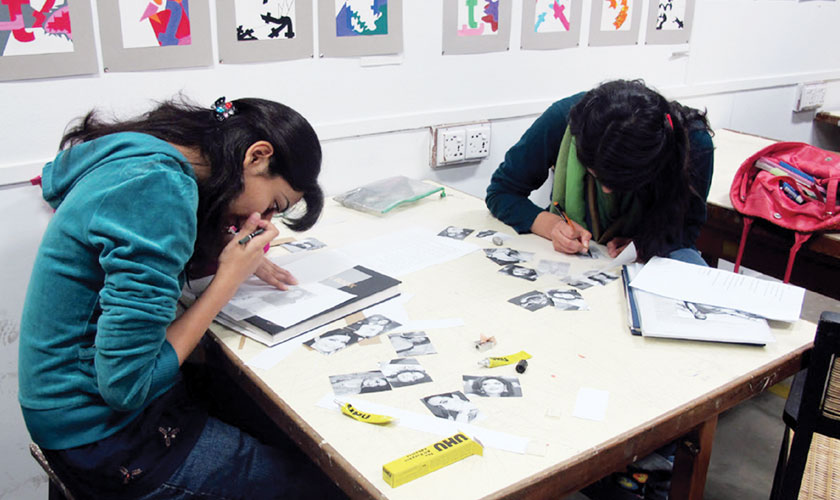Mahwish Ghulam Rasool is the Head of Department (HoD) of the Interior Design Department, Indus Valley School (IVS). She has done B.Arch and M.Arch from NED University of Engineering
New field, new prospects
Mahwish Ghulam Rasool is the Head of Department (HoD) of the Interior Design Department, Indus Valley School (IVS). She has done B.Arch and M.Arch from NED University of Engineering and Technology’s Department of Architecture and Planning. She is certified by Pakistan Council for Architects & Town Planners and Institute of Architects of Pakistan. She has worked for Impact Design International (an architecture and interior design firm) and Habitt.

Being an interior design student still in foundation year, this interview presented me with a perfect chance to learn more about my HoD, the opportunities that interior design students get and the challenges they face. Hopefully, this interview will prove to be helpful to potential students who want to be a part of IVS and its interior design department.
What’s your vision?
The prime vision is to create designers who are creative, contextually sensitive and who can challenge the norms of the society. We want to create minds that can not only think, but are ready for future challenges. Graduates are expected to be exceptional practitioners and thoughtful professionals.
Impact Design International and Habitt are both big entities. After working in the corporate sector, why did you choose to head the Interior Design Department at IVS?
I am an architect by profession, and in my practice I have mostly handled corporate interiors projects. I have a strong passion towards interior architecture as it’s a blooming field around the world and Pakistan has a great market and niche for it.
Honestly, the reason why I chose to lead this department was not easy when I was invited to do so. I knew that I was taking a huge risk and challenge but I have taken it and never regret it.

What’s the scope of interior design for students? How would you describe your subject?
Sky is the limit, I would say as it’s a sub-field of architecture. It’s a fast growing profession worldwide with the challenges to create environment for human comfort which is not an easy task.
It’s not only about doing glamourous interior environment but also to readapt the existing infrastructure/architecture and make wonders out of it.
What facilities are available for the students?
We have well-equipped studios, labs and material resource lab for our students besides the other shared facility on the campus. We are introducing newest software tools for the students so that they can work in any environment any context possible around the world.
What does your Interior Design Department offer its students in terms of placement and career counselling?
We send our students for credited internships to architecture and interior design firms so they can get a feel of the working environment before joining the field. We give them constant exposure during thesis and other juries sessions with different practitioners and have multiple career counselling session and a delegated course called “Professional Practice” to talk about the possible work environments, ethics roles and responsibilities. We do the major placements for our students.
How do you monitor and maintain the quality of education, and performance of your teachers and students?
It’s a tough one, honestly, as it goes hand in hand and I don’t judge the performance only in terms of grades or evaluations; there are many parameters to judge the performance. As faculty is also learning and adapting to the new system I try to motivate them. We have constant discussions on how to improve the quality of our teaching and I let both faculty and students experiment. I always tell students to never let failure discourage them; it should only spur them on to work harder.
How do you deal with underachieving students?
Well, there are two kinds of students in this category: ones who are hardworking but fall short of required marks and then there are those who are not interested in the profession. We constantly try our best to counsel them and since past three years our dropout ratio and failing ratio has decreased to one or two percent and the size of our graduating batch is increasing.
How do you improve the quality of teaching and the learning process? For example, how would you deal with a senior member of your team who is not doing justice and falling down in some area of practice, or refusing to implement a department policy?
It’s quite simple; I take charge. I believe in setting an example first before expecting my team to do something.
How do you motivate your staff?
I don’t talk about their failures. I talk about success and as a rule before critiquing, I always say something positive. On Fridays, I show them the latest projects, events happening around the work and guide them to polish their respective skills. I urge them to never follow others’ footsteps as everyone has a unique path.
What do you think are the biggest challenges that your department faces?
Acceptability. It is a new and different field and there is a massive need for interior designers in Pakistan.
What sort of help does government provide?
None! There are no councils, no codes or any bylaws for interior design practice in Pakistan. Currently, I am working on a module of codes which is in accordance with the AIID (American Institute of interior designers).
Is there any exchange programme/affiliation with the foreign universities? How do you assist students in getting scholarships locally and internationally?
We are working for two affiliations at present, and I can’t disclose it at the moment. I have a great channel of architects here and abroad and basically I assist them through my own personal links.
Does your department take part in community services?
Yes, we do it all the time and also involve our students in it. Currently, I am doing a public project for Karachi.
Name one thing about your department that most people don’t know.
We are not interior decorators. We train interior designers who specialise in interior architecture from residential, commercial, hospitality, adaptive reuse, etc.
Three misconceptions that people have about your department?
1. We are interior decorators
2. We cannot do architecture interventions
3. Interior designing is inferior to architecture (the most hilarious one).
Funny or weird things you hear about your department?
After graduating you can’t pursue a master’s degree in architecture.
Would you rather be liked or respected?
I would like to be remembered, respected and liked. I am as greedy as it takes :).
How would your students describe you?
My students describe me like an evil operator who will push them to their maximum creativity, and at the same time a mentor with whom they can talk from architecture, spaces books travel to let’s say about everything.
Best compliment you’ve ever received?
That I am a great mentor who can resolve any possible situation from design to everyday situation.
How do you handle criticism?
I think I take it very positively, as it makes you grow and makes your stronger. It enables you to sustain in worst possible situations. But having said that, know that I am more vigilant as I only talk about facts; I don’t deal in assumptions.
What do you worry about, and why?
Ignorance and people who talk on assumptions not facts.
Titles of the last three books you have read?
I want to name five as I have a strange habit of reading multiple books at a time. If it’s a dark book I prefer to combine it with humour:
1. Inferno
2. Party worker
3. Undomestic goddess
4. One Indian girl
5. Everything worth knowing